Review of fungi guidebooks
Some of the best fungi guides aren’t especially interested in wild food – in fact some have no information on edibility at all. Hopefully these brief reviews will help you select the best guide(s) for you. I strongly advise that you check at least 2 fungi guides before eating any wild mushroom.
Related pages:
- General guidance on foraging guidebooks and online resources
- General foraging guidebooks
- Plant foraging guidebooks
- Online foraging resources
- Wild Food Guide
- Further reading – coming soon
I have deliberately not provided links to web vendors – please consider paying a few extra £ on the high street if you wish to still have bookshops in 10 years time!
……………………………………………………………………………………………………………………………
Mushrooms and Toadstools of Great Britain and Europe by Roger Phillips (£25)
This has long been the essential text for those seeking to identify more than just basic edible and poisonous mushrooms in the UK.
Strengths
- Excellent, clear full-colour close-up photographs of fungi – often in various stages of growth and from various angles/sections
- Precise descriptions
- Covers all the species you are likely to encounter in the UK
- Information on edibility
- Notes on distribution/habitat
- List of top 20 most common species is useful
- Good visual key to aid identification
Weaknesses
- Dry, unexpansive text provides next to no foraging information or inspiration for beginners
- Little coverage on eating wild fungi beyond “Excellent/Edible/Inedible/Poisonous/Deadly”
- Wide range may overawe beginners
A great reference book to aid identification at home, but too big for use in the field.
……………………………………………………………………………………………………………………………
Mushrooming With Confidence (£16.99) by Alexander Schwab
An unusual fungi guide in that it doesn’t cover any poisonous, inedible or even non-delicious fungi. Instead it has lots of detailed photographs and ticklists for positive identification of 25 of the best and most common edible species. Mushrooming Without Fear by the same author is a slimmed down version of the same book covering even less species.
Strengths
- Lots of detailed pictures and descriptions of each species
- “Foolproof” tick-list for positive identification of each fungi
- Will not confuse beginners with look-alike mushrooms
Weaknesses
- Promotes a narrow view of fungi
- Includes Sheathed Woodtuft without mention of the very similar funeral bell. Regardless of precise checklists, I think this is potentially dangerous in a book aimed at novices.
- Ignores many common species
I have mixed opinions on this book. While the emphasis on positive identification is to be applauded, the narrow range covered means I only recommend it in conjunction with wider-ranging fungi guides.
……………………………………………………………………………………………………………………………
River Cottage Handbook No1 – Mushrooms (£14.99) by John Wright
A small hardback by RC’s affable wild food expert.
Strengths
- Highly entertaining and informative
- Lots of fascinating, useful and inspiring background information, fungi lore and science about both individual species and mushroom hunting in general
- Food-focussed with a great recipe section
- Substantial section covering important poisonous species
- Will not overwhelm beginners with too many inedible species
- Excellent colour photography
Weaknesses
- Little information on national distribution
- A list and some coverage of very common species would have been a nice addition
A really excellent introduction to picking wild mushrooms for the table. Highly recommended.
……………………………………………………………………………………………………………………………
Black’s Nature Guides – Mushrooms & Toadstools of Britain and Europe (£9.99)
A compact field guide covering 360 species of fungi.
Strengths
- Pocket-sized – a true field guide
- Excellent combination of colour photographs and illustrations to aid identification
- Great snippets of expert advice and interesting facts about each species
- Notes on habitat and geographic distribution
- Notes on edibility and poisonous lookalikes
- Well organised, clear and packs a lot into a small space
- Cheap
Weaknesses
- No recipes or cookery tips beyond basic safety
Highly recommended as a ‘first-stop’ field guide – this is the book I use when out in the woods.
……………………………………………………………………………………………………………………………
Field Guide to Mushrooms and other Fungi of Britain and Europe (£7.99) – Published by New Holland
A small paperback with a hard-wearing waterproof plastic cover detailing 200 species.
Strengths
- Lightweight, very compact and hard-wearing – a true field guide
- Excellent combination of colour photographs and illustrations to aid identification
- Clear and well laid out
- Cheap
- Notes on edibility and lookalikes for every species covered
Weaknesses
- No recipes or cooking tips
- Very little extra information on science, uses etc
- No information on geographic distribution
An excellent field guide, but not quite as good as Black’s Guide (above).
……………………………………………………………………………………………………………………………
Collins Complete Guide to British Mushrooms and Toadstools (£16.99) by Paul Sterry and Barry Hughs
A hefty glossy paperback photographic guide covering over 1000 British fungi.
Strengths
- Covers every fungi you are likely to encounter in the UK
- Detailed descriptions
- Includes excellent sections on lichenised fungi, tree identification and common species of particular habitats (eg. Oak woodland, bogs etc)
- Great chapter on the science of fungi and introduction of specific genera (eg. Boletes, Amanitas etc)
Weaknesses
- Virtually NO coverage of the edibility of species
- Most photographs show only the caps of mushrooms
- Little extra information on species beyond identification
- A bit bulky to be a useful field guide
Not for beginners, but useful for more experienced foragers wishing to expand their mycological identification skills beyond the commonplace and edible. A real shame there are so few pictures/diagrams of undersides of caps etc.
……………………………………………………………………………………………………………………………
Collins Fungi Guide (£35) by Stefan Buckzacki
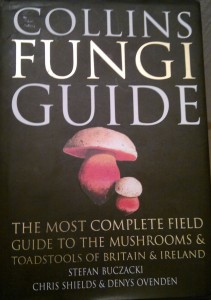
A compact, thick hardback covering over 2,400 species.
Strengths
- The most comprehensive guide to the fungi of Britain and Ireland available in the shops
- Excellent quality colour illustrations
- Detailed descriptions including spore shape
- Includes rare species
- Extensive visual key and information on detailed mycological study
- Notes on geographic distribution and rarity
Weaknesses
- Virtually NO information on edibility
- Small print (almost illegibly small print in index)
- Latin names only next to illustrations (common names in text)
- Only one idealised illustration of each species (no photographs)
- Utterly daunting for novices
- Expensive
- Too hefty to be a field guide
An excellent book for keen mycologists who wish expand their knowledge and identify rare species. Ironically more complete than Collins Complete Guide (above)!
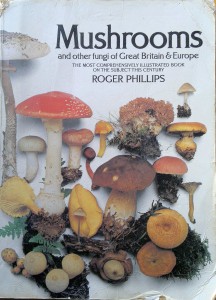
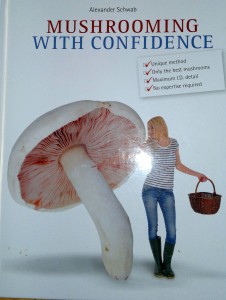
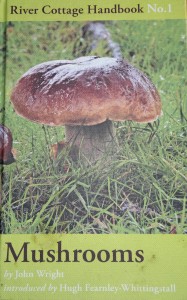
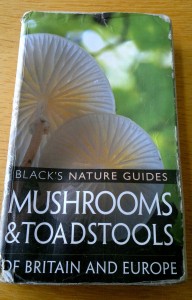


4 Comments
Great info
I am looking to forage for mushrooms and would like to ask you in your opinion what would be the best field book I could buy to help me ID edible Mushrooms and fungi.
Cheers
Scottish Bushman
On you tube
Hi Andy,
I’ve reviewed some here…not quite sure what more I can do..?
Hi Mark,
Thanks for the above information, it seems very concise.
I don’t suppose you may know where i can pick up a copy of the Black’s Nature Guides? I’m really struggling to find one anywhere and your alternative suggestion “Field Guide to Mushrooms and other Fungi of Britain and Europe” appears to have shot up in price (£52 is the cheapest i can find would you believe it)
cheers
Lewis
Just bought the John Wright book and about to buy Black’s too this was so useful! I’m a complete novice and I can’t wait to get started